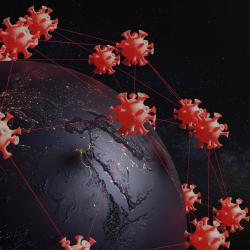Researchers Make Urgent Call for Study of Noise Pollution on Fish and Underwater Ecosystems
Public concern about the effects of underwater noise pollution on whales and dolphins has garnered attention in the media and the research literature over the past few decades. Much less attention has been devoted to understanding the impacts of noise pollution on fishes. But fish depend on hearing and sound for survival, and activities that cause underwater noise pollution are on the rise.
“There are currently so many fundamental knowledge gaps on the potential effects of anthropogenic sound to cause harm in fishes, that it is almost impossible to reach clear conclusions about the impacts of many human activities,” said Arthur Popper, professor emeritus of biology at the University of Maryland. Popper is the lead author of a review paper on the effects of human-generated, or anthropogenic, noise on fishes published on March 12, 2019 in the Journal of Fish Biology.
In the paper, Popper and co-author, Anthony Hawkins, former Director of Fisheries Research for Scotland and Coordinator of Fisheries Research for the UK, outlined what is known about the effects of anthropogenic noise on fishes, identified large gaps in data and called for the development of criteria for sound exposure that can be used to inform regulations.
Short pulses of very intense sounds, from such things as explosions, pile driving and seismic surveys, can be physically harmful to fishes, causing short term impairment or even death in animals close to the sound source. But lower intensity sounds may also have a significant effect on underwater ecosystems.
Sound travels great distances through water and is an important component of the underwater environment. Fishes use sound to communicate, navigate, forage, find prey and avoid predators. Activities such as shipping, offshore oil and gas exploration, dredging, trawling and other industrial pursuits may interfere with a fish’s ability to hear and respond to the natural sounds of its environment. Prolonged or continual sounds, such as those from shipping lanes, can have long-term effects on underwater soundscapes and cause behavioral changes in individual fish or whole communities.
It is clear that anthropogenic sound has the potential to impact fishes and the ecosystems they live in, but according to the paper, very few studies of those impacts exist. Most were conducted in laboratories on species of fish that thrive in captive conditions. Wild fishes behave very differently, and hearing sensitivity and frequency varies widely among the nearly 33,000 species of fish in the world. So, sounds will have different impacts on different fish species. What’s more, a multitude of conditions can affect the sound levels produced by a given activity, from topography and weather to the type of equipment used.
This new paper highlights the urgent need to examine the effects of different types of anthropogenic sounds on a variety of fish under varying conditions.
“Future research needs include investigations of how sound exposure might impair the ability of individual animals to survive, breed, reproduce, or rear young,” Popper said. “We need to quantify how this impairment may affect the abundance of the species concerned, as well as the extent to which sound affects the structure and functioning of fish populations and ecosystems, both marine and freshwater.”
According to the authors, research efforts should focus on developing criteria that define the levels of sound from different sources that are likely to negatively impact fish. From those criteria, informed regulations can be developed to manage noise in the aquatic environment.
“The goal must be to fill these gaps in our knowledge so that sound exposure criteria can be revised and improved,” Popper said.
To hear examples of different anthropogenic underwater sounds, go to: https://dosits.org/galleries/audio-gallery/anthropogenic-sounds/
###
The review paper “An overview of fish bioacoustics and the impacts of anthropogenic sounds on fishes” Arthur N. Popper and Anthony D. Hawkins was published online March 12, 2019 in the Journal of Fish Biology.
Writer: Kimbra Cutlip
Media Relations Contact: Abby Robinson, 301-405-5845, abbyr@umd.edu




